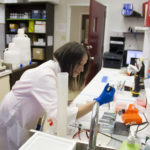I wrote my first lay summary after 11 months as a graduate student and the only experience I had communicating my work to non-scientific audiences was talking with my family. I’ve learned a lot since then as a writer, reader, and reviewer of lay summaries, as well as through my non-profit and science communication work.
Why are lay summaries important?
Stats Canada reports that in 2016, approximately two-thirds of adults, aged 25-64, have completed postsecondary education, which includes trades, apprenticeships, college, and bachelor’s level education. Of those, STEM comprises the major field of study for about one-quarter. In all, this means that the vast majority of people living in Canada have, at most, a high-school level education in science.
A significant amount of research is funded by the public, through government funding or through donations to charitable and non-profit organizations. One of the most important obligations of governments as well as non-profit organizations is to justify the dollars spent. When it comes to research, this is particularly challenging as many projects are funded based on potential – how we think research projects can affect people, the planet, or society. (As a health researcher, I am biased towards research that helps people, so my examples are all skewed towards biomedical.)
Justification occurs when reports are submitted – to Ministers, to staff, to Boards of Directors, or to other senior members. These reports often include summaries of the research funded. While these people are typically highly qualified for their positions, they don’t often have scientific backgrounds. For many of them, the last required science class they took was in grade 10, which could be many years ago.
How do you convince people who haven’t taken science since grade 10, that your work is important, essential, and worth the investment? Enter the lay summary.
What is a lay summary?
A lay summary is a concise summation of your work that is accessible to the general public. I’ve avoid using ‘abstract’ in the definition because I’ve seen a lot of scientists use it as an excuse to just copy whatever they’ve written as a scientific abstract into the ‘lay abstract’ box. There are a lot of differences! I know that writing a scientific abstract is already challenging, and here are funding bodies giving us all an even greater challenge.
Let’s start with a couple of challenges:
Challenge #1: Can you explain a hard idea using only the one thousand most used words? UP-GOER5 was developed by Theo Sanderson and is a huge challenge. Try just one scientific word or phrase from your research proposal… (https://splasho.com/upgoer5/. Your lay summary can use more complex words than this, but it’s a good way to ballpark what needs to change.
Challenge #2: Have you evaluated your document’s readability and reading level? I’d recommend trying this on a draft scientific abstract or lay summary. Microsoft Word has a great tool for this. https://support.microsoft.com/en-us/office/get-your-document-s-readability-and-level-statistics-85b4969e-e80a-4777-8dd3-f7fc3c8b3fd2
Some of the things you’ll have noticed is that complex words are pretty uncommon and increase the reading level. Complex sentences can be even more difficult to understand. What else did you notice? Feel free to share in the comments.
I’ve written a bunch of lay abstracts, read even more, and reviewed a number of them attached to research proposals. My opinion on writing them is my own: it might not be what your supervisor or your peers feel is best. Remember that you, me, our collective peers, and supervisors are mostly all scientists – the best feedback on a lay summary comes from a non-scientific audience.
Eight tips for your lay summary – the nitty gritty
- The people reading your lay summary are most likely not experts in your specific field. Don’t use jargon. ‘Highly fragmented’ can be ‘very short’ and still get the concept across.
- Focus on the impact to people, planet, or society – things that a grade 10 student can understand. “Identifying patients with a specific type of lung cancer who will benefit from a different type of therapy” is better than “Using a probabilistic model to determine which individuals with non-small-cell lung adenocarcinoma would benefit from X chemotherapeutic regimen over Y”. (Not picking on lung cancer researchers here, I promise!)
- If you’ve read a newspaper article (online, or in print) you’ll see that the first sentence is designed to grab your attention and entice you to keep reading – that’s called a lede. I suggest you use one! As scientists, we often think linearly from background to problem to hypothesis, but most non-experts will stop reading if it’s not immediately interesting. (When was the last time you read a journal article that wasn’t related to something you’re already curious about?) “This research will change the way we think about chemotherapy for patients with breast cancer,” is going to grab more attention than, “Breast cancer is a serious disease affecting 1 in X Canadians every year.”
- Your research is way more complicated than you can describe in a lay summary. For example, I’m looking at non-coding mutations that affect the splicing of a specific gene in a specific subtype of non-Hodgkin lymphoma, but I’ve summarized that as “investigate how this affects the behaviour of mantle cell lymphoma and other types of non-Hodgkin lymphoma”.
- LIMIT YOUR ABBREVIATIONS. I can’t say this enough. It’s hard enough as an expert to read a sentence in which every second word is an abbreviation that was introduced a paragraph ago or even earlier. (I bet you know what I mean!) Now imagine being a non-expert: “how G-to-A mutations in HNRNPH1 affect MYC expression in MCL, a type of NHL,” becomes almost impossible to decipher. (Also note that this is just an example, and not an actual experimental goal.) Common abbreviations are totall OK. Something like ‘DNA’ is reasonable to include, but ‘RNA’ is not as well known. If you need to use abbreviations to fit within the word count, see #6 and #7!
- Less detail is almost always better. The average person doesn’t need to know each of the specific objectives or aims of your research. Keep it simple: what are you trying to accomplish? What are you going to do? Something like ChIP is already too detailed – what’s the very basic question you’re trying to answer? How will people know when you’ve succeeded? cfme-DIP-seq might be the most cutting-edge technique in your project, but it’s a lot to understand even for an educated biological expert studying a slightly different topic.
- Following from #5 and #6, limit new terms or concepts to just one. In my most recent lay summary, I introduced mutations: “…these arise from errors, known as mutations, in the DNA of a cell,” and then went on to describe that, “these errors provide cells with incorrect or incomplete instructions…” This is accurate, although imprecise, but it was the one concept necessary to understand the rest of my lay summary. Maybe your one concept is a specific gene that carries out an important function… or a specialized technique that will give us new information on a topic you’re researching.
- Take out any passive language. A hint to figure out if it’s passive: can you add “by aliens” to the end? “The size of tumors will be measured,” Is a passive phrase (you can add, ‘by aliens,’ to the end and it still makes sense – except for the aliens of course). Try “I will measure the size of the tumors.” (For example only, because this doesn’t provide any meaning to the size of tumors.)
I hope these tips have given you a framework for writing and editing your lay summary. The best editor is still going to be someone who hasn’t taken a science class since they were in high school! I’m not promising you success, but I am promising you a summary that is easier for the general public to read than your scientific abstract.
Please pass on your suggestions and comments below!


 sed to joke that I had sold my soul to science. A few years later, I have realized that I owe it to myself to make sure science doesn’t take my soul. That doesn’t mean I am any less dedicated, any less successful, or any less of a scientist. It means that I value what science brings to my life and what my life experience brings to science.
sed to joke that I had sold my soul to science. A few years later, I have realized that I owe it to myself to make sure science doesn’t take my soul. That doesn’t mean I am any less dedicated, any less successful, or any less of a scientist. It means that I value what science brings to my life and what my life experience brings to science.